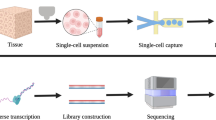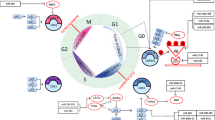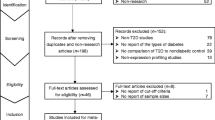Abstract
Micro-RNAs (miRNAs) are small noncoding RNAs that negatively regulate gene expression at protein level by protein translation inhibition or mRNA degradation. However, the global correlation patterns between miRNA and protein have not been studied yet. To establish the global correlation patterns in human peripheral blood mononuclear cells (PBMCs), this study conducted multiple types of miRNA–protein correlation analyses in 28 Chinese subjects. Pearson correlation analysis showed a negative but relatively small global correlation in each subject. Among the 371 constructed miRNA–protein pairs (60 unique miRNAs, and 150 unique proteins), 10.5% of pairs have significant correlations (P < 0.05). Some highlighted miRNAs (e.g., hsa-miR-590-3p, hsa-miR-520d-3p) exerted significant regulation on multiple genes. Simultaneously, some genes (e.g., HSP90B1) were targeted by multiple miRNAs. The target genes associated with miRNAs tend to enrich in some important GO terms: biological processes (e.g., gene expression, protein binding and RNA binding), and molecular functions (protein binding: GO:0005515; RNA binding: GO:0003723). The results provided a global view of the miRNA–protein expression correlation profile in human PBMCs, which would facilitate in-depth investigation of biological functions of key miRNAs/proteins and better understanding of the pathogenesis underlying PBMC related diseases.



Similar content being viewed by others
References
Sevignani C, Calin GA, Siracusa LD, Croce CM (2006) Mammalian microRNAs: a small world for fine-tuning gene expression. Mamm Genome 17:189–202
Takamizawa J, Konishi H, Yanagisawa K, Tomida S, Osada H, Endoh H, Harano T, Yatabe Y, Nagino M, Nimura Y, Mitsudomi T, Takahashi T (2004) Reduced expression of the let-7 microRNAs in human lung cancers in association with shortened postoperative survival. Cancer Res. https://doi.org/10.1158/0008-5472.CAN-04-0637
Van Rooij E, Sutherland LB, Liu N, Williams AH, McAnally J, Gerard RD, Richardson JA, Olson EN (2006) A signature pattern of stress-responsive microRNAs that can evoke cardiac hypertrophy and heart failure. Proc Natl Acad Sci USA. https://doi.org/10.1073/pnas.0608791103
Tsuchiya S, Okuno Y, Tsujimoto G (2006) MicroRNA: biogenetic and functional mechanisms and involvements in cell differentiation and cancer. J Pharmacol Sci. https://doi.org/10.1254/jphs.CPJ06013X
Liu W, Mo SY, Zhu WY (2007) Impact of tiny miRNAs on cancers. World J Gastroenterol. https://doi.org/10.3748/wjg.v13.i4.497
Shukla GC, Singh J, Barik S (2011) MicroRNAs: processing, maturation, target recognition and regulatory functions. Mol Cell Pharmacol. https://doi.org/10.4255/mcpharmacol.11.13
Friedman RC, Farh KKH, Burge CB, Bartel DP (2009) Most mammalian mRNAs are conserved targets of microRNAs. Genome Res. https://doi.org/10.1101/gr.082701.108
Bartel DP (2004) MicroRNAs: genomics, biogenesis, mechanism, and function. Cell. https://doi.org/10.1016/S0092-8674(04)00045-5
Shalgi R, Lieber D, Oren M, Pilpel Y (2007) Global and local architecture of the mammalian microRNA-transcription factor regulatory network. PLoS Comput Biol. https://doi.org/10.1371/journal.pcbi.0030131
Baskerville S, Bartel DP (2005) Microarray profiling of microRNAs reveals frequent coexpression with neighboring miRNAs and host genes. RNA. https://doi.org/10.1261/rna.7240905
Wang YP, Li KB (2009) Correlation of expression profiles between microRNAs and mRNA targets using NCI-60 data. BMC Genom. https://doi.org/10.1186/1471-2164-10-218
Laxman N, Rubin CJ, Mallmin H, Nilsson O, Pastinen T, Grundberg E, Kindmark A (2015) Global miRNA expression and correlation with mRNA levels in primary human bone cells. RNA. https://doi.org/10.1261/rna.049148.114
Cox J, Neuhauser N, Michalski A, Scheltema RA, Olsen JV, Mann M (2011) Andromeda: A peptide search engine integrated into the MaxQuant environment. J Proteome Res. https://doi.org/10.1021/pr101065j
Cox J, Mann M (2008) MaxQuant enables high peptide identification rates, individualized p.p.b.-range mass accuracies and proteome-wide protein quantification. Nat. Biotechnol. https://doi.org/10.1038/nbt.1511
Favero F (2006) RmiR: package to work with miRNAs and miRNA targets with R. R package version 1.10.0. https://www.bioconductor.org/packages/release/bioc/html/RmiR.html
Lewis BP, Shih IH, Jones-Rhoades MW, Bartel DP, Burge CB (2003) Prediction of mammalian microRNA targets. Cell. https://doi.org/10.1016/S0092-8674(03)01018-3
Papadopoulos GL, Reczko M, Simossis VA, Sethupathy P, Hatzigeorgiou AG (2009) The database of experimentally supported targets: a functional update of TarBase. Nucleic Acids Res. https://doi.org/10.1093/nar/gkn809
Krek A, Grün D, Poy MN, Wolf R, Rosenberg L, Epstein EJ, MacMenamin P, Da Piedade I, Gunsalus KC, Stoffel M, Rajewsky N (2005) Combinatorial microRNA target predictions. Nat Genet. https://doi.org/10.1038/ng1536
Guo Y, Xiao P, Lei S, Deng F, Xiao GG, Liu Y, Chen X, Li L, Wu S, Chen Y, Jiang H, Tan L, Xie J, Zhu X, Liang S, Deng H (2008) How is mRNA expression predictive for protein expression? A correlation study on human circulating monocytes. Acta Biochim Biophys Sin (Shanghai). https://doi.org/10.1111/j.1745-7270.2008.00418.x
Jin CD (1993) Multivariate quantitative correlation analysis of chemical constituents of peony root in different collecting seasons. Zhongguo Zhong Yao Za Zhi. 18:333–334
Shannon P, Markiel A, Ozier O, Baliga NS, Wang JT, Ramage D, Amin N, Schwikowski B, Ideker T (2003) Cytoscape: a software environment for integrated models of biomolecular interaction networks. Genome Res. https://doi.org/10.1101/gr.1239303
Huang DW, Sherman BT, Lempicki RA (2009) Systematic and integrative analysis of large gene lists using DAVID bioinformatics resources. Nat Protoc. https://doi.org/10.1038/nprot.2008.211
Benjamini Y, Hochberg Y (1995) Controlling the false discovery rate: a practical and powerful approach to multiple testing. J R Stat Soc Ser B. https://doi.org/10.1111/j.2517-6161.1995.tb02031.x
Maier T, Güell M, Serrano L (2009) Correlation of mRNA and protein in complex biological samples. FEBS Lett 583:3966–3973. https://doi.org/10.1016/j.febslet.2009.10.036
Schwanhüusser B, Busse D, Li N, Dittmar G, Schuchhardt J, Wolf J, Chen W, Selbach M (2011) Global quantification of mammalian gene expression control. Nature. https://doi.org/10.1038/nature10098
Wang L, Zhu J, Deng FY, Wu LF, Mo XB, Zhu XW, Xia W, Xie FF, He P, Bing PF, Qiu YH, Lin X, Lu X, Zhang L, Yi NJ, Zhang YH, Lei SF (2018) Correlation analyses revealed global microRNA–mRNA expression associations in human peripheral blood mononuclear cells. Mol Genet Genom 293:95–105. https://doi.org/10.1007/s00438-017-1367-4
Penalvaa LO, Marcotte EM, Vogel C, de Sousa Abreua R (2014) Global signatures of protein and mRNA expression levels. Mol Biosyst 5:1512–1526. https://doi.org/10.1039/b908315d.Global
Liu R, Li J, Lai Y, Liao Y, Liu R, Qiu W (2015) Hsa-miR-1 suppresses breast cancer development by down-regulating K-ras and long non-coding RNA MALAT1. Int J Biol Macromol. https://doi.org/10.1016/j.ijbiomac.2015.08.016
Wang T, Yuan J, Feng N, Li Y, Lin Z, Jiang Z, Gui Y (2014) Hsa-miR-1 downregulates long non-coding RNA urothelial cancer associated 1 in bladder cancer. Tumor Biol. https://doi.org/10.1007/s13277-014-2321-2
Fang C, Xu L, He W, Dai J, Sun F (2019) Long noncoding RNA DLX6-AS1 promotes cell growth and invasiveness in bladder cancer via modulating the miR-223-HSP90B1 axis. Cell Cycle. https://doi.org/10.1080/15384101.2019.1673633
Sunil Kumar BV, Bhardwaj R, Mahajan K, Kashyap N, Kumar A, Verma R (2018) The overexpression of Hsp90B1 is associated with tumorigenesis of canine mammary glands. Mol Cell Biochem. https://doi.org/10.1007/s11010-017-3152-4
Graustein AD, Misch EA, Musvosvi M, Shey M, Shah JA, Seshadri C, Aguoju A, Bowman K, Mulenga H, Veldsman A, Hanekom WA, Hatherill M, Scriba TJ, Hawn TR (2018) Toll-like receptor chaperone HSP90B1 and the immune response to Mycobacteria. PLoS ONE. https://doi.org/10.1371/journal.pone.0208940
Sun X-X, Li S-S, Zhang M, Xie Q-M, Xu J-H, Liu S-X, Gu Y-Y, Pan F-M, Tao J-H, Xu S-Q, Liu S, Cai J, Wang D-G, Qian L, Wang C-H, Lian L, Xiao H, Chen P-L, Liang C-M, Fang Y-B, Zhou Q, Huang H-L, Su H, Pan H-F, Ye D-Q, Zou Y-F (2018) Association of HSP90B1 genetic polymorphisms with efficacy of glucocorticoids and improvement of HRQoL in systemic lupus erythematosus patients from Anhui Province. Am J Clin Exp Immunol 7:27
Lambert B, Vandeputte J, Remacle S, Bergiers I, Simonis N, Twizere JC, Vidal M, Rezsohazy R (2012) Protein interactions of the transcription factor Hoxa1. BMC Dev Biol. https://doi.org/10.1186/1471-213X-12-29
Funding
The study was supported by Natural Science Foundation of China (81872681, 81373010, 81473046, 81502868, 81541068, 31401079, and 81401343), the Natural Science Foundation of the Jiangsu Higher Education Institutions of China (16KJA330001) and a Project of the Priority Academic Program Development of Jiangsu Higher Education Institutions. Funding was provided by Natural Science Foundation of Jilin Province (Grant No. 560 thousand yuan).
Author information
Authors and Affiliations
Corresponding author
Ethics declarations
Conflict of interest
The authors declare that they have no conflict of interest.
Ethical approval
This study was approved by Institutional Research Ethic Board at the Soochow University.
Informed consent
All subjects signed informed consent forms before participating in the project. The collection and use of human materials for the present study were approved by Institutional Research Ethic Board at the Soochow University. Informed consent forms were collected from all the participants before entering the study.
Research involving human and animal participants
The study has involved human participants. Twenty-eight unrelated Chinese Han adult females from the region of Suzhou city of China were recruited from an ongoing project with original aim of investigating genetic and genomic factors of rheumatoid arthritis (RA) using multi-omics strategies. All the study subjects were excluded from serious diseases involving vital organs (brain, liver, kidney, heart or lung).
Additional information
Publisher's Note
Springer Nature remains neutral with regard to jurisdictional claims in published maps and institutional affiliations.
Electronic supplementary material
Below is the link to the electronic supplementary material.
Rights and permissions
About this article
Cite this article
Huang, L., Deng, FY. & Lei, SF. Global correlation analysis for miRNA and protein expression profiles in human peripheral blood mononuclear cells. Mol Biol Rep 47, 5295–5304 (2020). https://doi.org/10.1007/s11033-020-05608-y
Received:
Accepted:
Published:
Issue Date:
DOI: https://doi.org/10.1007/s11033-020-05608-y




